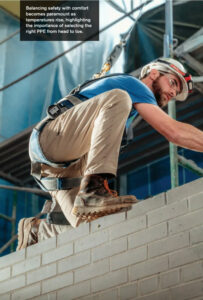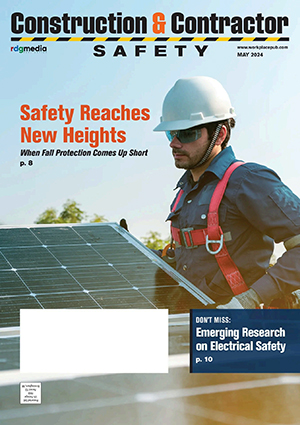Mitigating the Risks of Heat Stress and Related Injuries
By Tito Warren, Contributor
 During the scorching summer months, safety professionals on construction sites brave challenging conditions as they work to combat heat stress and related injuries. In order to manage heat-related risks, safety professionals must have the tools and resources to identify and help prevent work hazards before an incident occurs. Mitigation protocols and PPE both play key roles in keeping workers safe. [
During the scorching summer months, safety professionals on construction sites brave challenging conditions as they work to combat heat stress and related injuries. In order to manage heat-related risks, safety professionals must have the tools and resources to identify and help prevent work hazards before an incident occurs. Mitigation protocols and PPE both play key roles in keeping workers safe. [
Safety professionals can take the following strategies to help protect their workers from heat stress and related injuries on construction sites.
Understand the Risks
New in 2024, The American Society of Safety Professionals (ASSP) has published the first national voluntary consensus standard addressing heat stress for workers in construction and demolition operations.[1] With workers frequently facing outdoor hazards brought on by high temperatures and humidity, this is an important development within the industry due to the lack of federal regulation focused on heat stress.
Working in extreme temperatures poses a multitude of risks for construction workers, ranging from heat exhaustion and dehydration to sunburns and heat stroke. According to the U.S. Department of Labor Occupational Safety and Health Administration (OSHA), most outdoor fatalities, 50% to 70%, occur in the first few days of working in warm or hot environments due to the body needing to build a tolerance to the heat gradually over time.
While safety managers are no strangers to heat-related challenges, it is important to continuously evaluate the risks and know all your options in order to protect the health and safety of your workers.
Put Preventative Systems in Place
In advance of the summer months, consider putting systems in place, or revising existing programs, to help safeguard workers from heat stress. These could include:
- Heat Safety Protocols: Establish protocols for monitoring and managing heat-related risks on the job site, including scheduled breaks in shaded or air-conditioned areas, regular hydration reminders, and adjustments to work schedules to avoid peak heat hours. For example, water is critical when working in hot weather. According to the CDC, workers should drink up to one cup of water, every 15-20 minutes to prevent dehydration.[2] Additionally, consider utilizing urine charts in the restroom on your worksite. As dark urine can suggest dehydration, workers can use the chart to determine if they should drink more water.
- Safety Culture: Foster a culture of open communication where workers feel comfortable voicing concerns about heat-related discomfort or symptoms. Encourage environments where leaders actively listen to workers’ feedback and address any issues promptly to ensure their safety and well-being.
- Education and Training Programs: Consider implementing a heat stress prevention program to provide comprehensive training on the importance of heat safety during summer projects. Train workers to identify risk factors and to recognize the signs of heat-related illnesses and empower them to take proactive measures to stay safe in hot weather conditions.
Provide the Right Equipment
Even though PPE is non-negotiable for ensuring compliance with OSHA regulations and safeguarding against physical hazards, it’s crucial to prioritize gear that offers adequate protection without exacerbating heat-related discomfort. Balancing safety with comfort becomes paramount as temperatures rise, highlighting the importance of selecting the right PPE from head to toe. While you should work with your PPE provider on a job hazard analysis (JHA) to determine the right equipment for your workforce, here are a few considerations to keep in mind to combat heat stress:
- Neck Gaiters: When worn properly, neck gaiters can help regulate body temperature, protect workers against excessive heat exposure, offer sun protection, and are often more practical on job sites, especially when brimmed hard hats can become cumbersome. They also serve multiple purposes beyond headgear – for example, a dampened neck gaiter can provide instant cooling by simply wetting it with cold water. Look for neck gaiters made from moisture-wicking fabrics that pull sweat away from the skin.
- UV-Resistant Safety Glasses: Shielding the eyes from harmful UV rays is essential for outdoor workers exposed to bright sunlight. Choose safety glasses with UV protection and polarized lenses to reduce glare and minimize eye strain, enhancing both safety and visual comfort.
- Moisture-Wicking Workwear: Lightweight fabrics with moisture-wicking properties are crucial for keeping workers dry and comfortable in the heat. Look for workwear garments that are designed to draw sweat away from the skin, allowing for rapid evaporation and heat dissipation. Additionally, venting details on jackets, coveralls, and other pieces of clothing aid in air circulation to keep workers cool. Avoid cotton materials that retain moisture.
- Breathable Boots: Keeping feet dry and cool is imperative so workers don’t slip and fall on the job or develop blisters. For work boots, workers should select foot protection with breathable materials and look for manufacturers with technology that surrounds feet with cooling, conductive fibers to move heat away from the skin.
Beat the Heat
As summer temperatures soar, ensuring the safety and well-being of workers is critical. By equipping workers with proper PPE and implementing effective heat safety protocols, safety professionals can mitigate the risk of heat-related illnesses and create a safer, more comfortable work environment.
Tito Warren is the President of Global Industrial Sales and Operations, Red Wing Shoe Company (redwingshoes.com).
[1] https://store.assp.org/PersonifyEbusiness/Store/Product-Details/productId/260687328?_ga=2.143566261.1464348989.1710943854-1064670163.1710943854
[2] https:/www.cdc.gov/niosh/mining/userfiles/works/pdfs/2017-126.pdf



